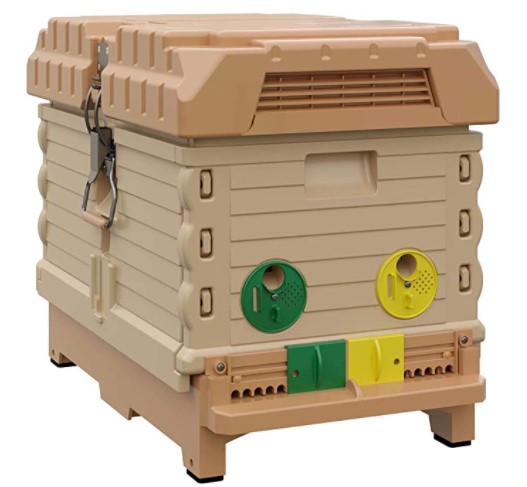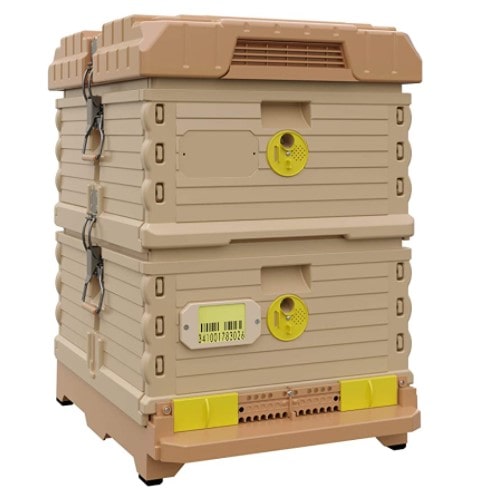Honeybees need very special conditions to stay in a beehive. The materials used to construct a beehive decide whether it is suitable for bees. Traditionally, wood has been the favored material for beehive building. Plastic, on the other hand, has been shown to be useful in beekeeping, especially the construction of beehives. So, is plastic beehive a suitable alternative?
Considerations when choosing beehive material.
There are several aspects to consider before deciding on the material for your beehive. When creating your beehive, you may opt to use materials that are readily available in your area. It is also critical to evaluate the cost of purchasing these materials. Here are some important considerations to consider.
-
Beehive integrity over time
Beehives and warping going out of shape causes bees to draw combs in places where they should not. There are several methods for waterproofing beehives, including painting the outside surfaces of the beehive with oil-based paints. On the other hand, plastic is not biodegradable. The majority of the plastic used in the construction of beehives is molded into a certain shape. This means that repairing a broken element necessitates the replacement of the complete beehive box.
-
Insulation
Your beehive material of choice should not transfer heat away from or into the hive. Honeybees respond differently to temperature changes. Hot temperatures in the beehive induce bees to work together to reduce them, whilst cold conditions cause bees to cluster together. This is why metal is not utilized in the construction of beehives.
-
Food-Safe
Food safety is critical in beekeeping. All beehive products are ingested by humans. As a result, beehive materials must be food-safe. Plastic’s composition allows it to decompose very slowly, with carbon components separating off. Heat is what causes polymers to deteriorate. If even small amounts of these polymers appear in your honey, it will no longer be safe to consume.
-
Pests, diseases and parasite control
Threats to beekeeping are something that beekeepers must deal with. In the worst-case scenario, the honeybee colony abandons the beehive in search of a better home. The beehive material you choose must not harbor honeybee pests and parasite eggs. Furthermore, the material should not include vegetative spores of bacteria and fungus that cause honeybee illnesses.
-
Adaptability to a wide range of beekeeping needs
In beekeeping, beehives must be flexible to other uses. A beehive box may be required at times to serve as a swarm trap or for other purposes. Such modifications are required to accommodate your beekeeping methods. It should also be simple to brand and install security gadgets made from this material. Beekeepers should select materials that allow the beehive and its compartments to adjust to changing needs.
Characteristics of wooden beehives
Wooden beehives have been used for centuries. They come in a variety of sizes and combinations to suit the needs of beekeepers. Wooden beehives are readily welcomed by bees.
-
Advantages of wooden beehives
Beekeepers with woodworking experience can simply construct their own robust and lasting beehives. You may also find excellent wooden beehives at moderate prices. It is possible to improve the life of the wooden honeycomb. Beekeepers who shelter and paint their wooden beehives get a surprising length of life and excellent service from their wooden beehives.
With hardwood honeycombs, weight is not an issue. It is simply modifiable and aids in humidity control in the hive. Allows for the simple repair and replacement of worn, damaged, or broken components and pieces. Furthermore, wood is the only substance that naturally attracts bees.
-
Disadvantages of wooden beehives
Despite their many benefits, hardwood honeycombs can rot and degrade over time if not properly maintained. Furthermore, wood serves as a breeding ground for insects and parasites. They frequently hide in the seams and joints.
Characteristics of plastic beehives
-
The Benefits of Plastic Beehives
The plastic beehives have slots for feed, entry reducers, and screened bottoms. They also contain provisions for pollen traps. These plastic beehives are also available in a variety of colors to fit your personal preferences. The plastic honeycombs still feature advanced ventilation. They lock into place via a variety of processes and are relatively resistant to huge predators attempting to enter the beehive. Many plastic beehive makers employ food-grade recyclable plastic. When you utilize a plastic beehive, you save money on maintenance.
-
Limitations of plastic beehives
Plastic honeycombs are not suitable for cold climates. Flimsy plastic beehives collapse and may result in the loss of your honeybee colony. Condensation easily forms in plastic honeycombs. Many beekeeping equipment manufacturers are inexperienced and are not molded to exact dimensions. As a result, some plastic beehive sections and components may not fit together.
Best Plastic Beehives
-
Apimaye Insulated 7 Frame Langstroth Nucleus Bee Hive Nuc

The Apimaye beekeeping kit is suitable for both novice and professional beekeepers. However, because it only has 7 frames, it is not as huge as its older 10-frame brother. As a result, because it is not the largest unit, it may not be sufficient for huge, developing colonies. It is also good for establishing a new colony. You have the option of adding more supers to this to further extend your colonies.
-
Apimaye Insulated Plastic Langstroth Beehive

The hive starter package includes 20 plastic frames, which are large enough for your colony to thrive. The insertion board has the ability to split the colony. You will also need to purchase some additional equipment, such as tools and safety equipment. Overall, for those who can afford it, this is an excellent beekeeping beginner package. It gives your colony lots of room to flourish and allows for more pile up.
Conclusion
In beekeeping, plastic is making inroads into wood. However, the use of plastic in honeycomb construction must solve the problems of food safety and condensation. Wood has long dominated beehive construction. It is a naturally occurring substance that bees adore. Use comparison of plastic and wooden beehives to help you decide which material to use in your beehives.
>>> Read more: Top 10 Best Mason Bee Houses – Review And Buying Guide
